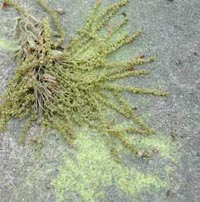Resource Library
Plant of the Week: Pollen, Oak
The University of Arkansas System Division of Agriculture does not promote, support or recommend plants featured in "Plant of the Week." Please consult your local Extension office for plants suitable for your region.
Plant of the Week
Oak Pollen

Watery eyes and sneezing tell us that pollen season is upon us again.
One of the joys of living in "The Natural State" is the beauty of the trees. Out-of-state visitors are always taken aback by the natural beauty of Arkansas, much of which is provided by our trees. But living in such a tree-blessed state comes at a cost. Pollen!
All flowering plants produce pollen but nature has evolved different methods to get it to the point where it is needed; the end of the pistol where the process of fertilization begins.
Flowers, even though we're entrusted with their care and feeding, are not designed for humankind but to attract the attention of the birds and bees. Plants with pretty, showy flowers are almost always insect-pollinated and usually have pollen grains that are too large to cause allergies.
It's the plants that don’t have showy flowers - cedars, oaks, pines, hickories, grass, and the all-important ragweed that make the lives of thousands of allergy sufferers miserable each year. These plants have chosen wind pollination as their means of procreation, and an effective method it is.
Allergy doctor Tina Hatley with the Northwest Arkansas Allergy Clinic in Rogers tells me this is shaping up to be a good year for her business. She says Arkansas is geographically situated to have more allergy problems than other areas. We not only have lots of trees and grasslands to cause mischief with our immune system, but our winters are not cold enough to stop mold spores from being produced during the winter.
The nightly weather report always gives us an allergy count, courtesy of two certified counting centers in the state - in Little Rock and Fort Smith. The Fort Smith count is done as a service by the Northwest Allergy Clinic and uses a device called the Burkhard Pollen Counter.
Allergy collecting sites are perched up in the air atop a tall tower or on a rooftop. They want to be above the tree line so they get an average reading. Pollen is very light and is carried on wind currents for long distances. According to Hatley, pollen from the Ashei junipers of central Texas is routinely reported in Canada.
This machine uses a vacuum to collect an air sample over a 24-hour period. Particulates in the air are deposited on a clear jell, which the technician collects daily and then stains. Spores are counted under a microscope and identified as to species and number recorded. A formula is used to extrapolate the actual count to the number of spores per given volume of air.
The National Allergy Bureau has established standards, based on human response, to designate allergy levels from low to very high, depending on the number of pollen grains counted. Counts above 1,500 grains per cubic meter of air are considered very high for tree pollen. This time of year we are in the "very high" designation, often with counts of over 5,000.
Hatley says oak and grass pollen bothers many people, but it's probably cedar (Juniper) pollen that bothers the largest number of people in our area. She says a good rain will wash pollen from the air, but it also invigorates the plants, and in a few days they'll produce even more pollen.
Allergy sufferers can make it through the pollen season with the minimum discomfort by following some common-sense suggestions. First, minimize outdoor activity between 5 and 10 a.m., the period when pollen counts are usually the highest. Keep the house and car windows closed and use air conditioning to stay cool. Keep filters clean and keep the inside of the house clean and tidy.
Over-the-counter antihistamines can help alleviate allergy problems. If the problem is ongoing and severe, allergy doctors can prescribe treatments that will combat the specific allergy problem.
By: Gerald Klingaman, retired
Extension Horticulturist - Ornamentals
Extension News - April 16, 2004
The University of Arkansas System Division of Agriculture does not maintain lists of retail outlets where these plants can be purchased. Please check your local nursery or other retail outlets to ask about the availability of these plants for your growing area.